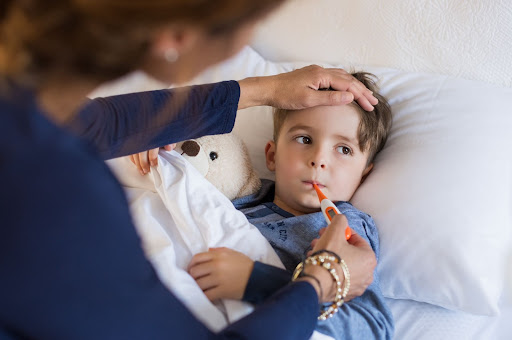Contributions by: Ashton Thornton, RN, BScN
In most illnesses, it’s common to come down with a fever. While we have all had a fever at least once, that doesn’t make parents less worried when their little one gets sick and has a fever.
That’s why our KixTeam has put together this ‘Fever Survival Guide’ so you know if your child has a fever, what to do to help them, and when it requires medical attention.
How do I take my child’s temperature?
There are several ways to take your child’s temperature. Still, the most common methods are:
- Rectal (by the rectum or ‘bum’)
- Oral (by the mouth)
- Axillary (under the armpit)
- Tympanic (in the ear)
- Non-contact Infrared Thermometer (forehead)
Which method should I use?
Typically, we recommend using the Rectum method if your child is under 1 years old and you know how to use that method safely. If you’re unsure about using the Rectum method, we recommend using the Axillary method.
We recommend using the Axillary method for kids aged 2-5 years old, but you can also use the Oral or Tympanic methods as alternatives.
As soon as your little one can keep the thermometer under their tongue with their mouth close tight for the required testing time, we recommend the Oral method.
What is considered a fever?

What can I do to help my child with a fever?
The best thing you can do for your child if they have a fever is:
- Offer them lots of fluids (water, Pedialyte, apple juice, and soup).
- Keep them comfortable.
- Remove extra blankets or layers, but keep some clothes on so they don’t get too cold.
- If your child is older than 3 months, you can give them the recommended dose of Ibuprofen and/or Acetaminophen to help lower the fever.
When should I contact my healthcare provider?
You should seek further medical assistance if:
- You’re concerned that your child may be dehydrated. If your child is dehydrated, they will have little to no urine output, and their diapers will barely be wet.
- Your child is under 3 months old and has a fever.
- Your child has had a fever for more than 5-7 days.
- Your child is excessively sleepy, sluggish or unresponsive.
- Your child has a purplish rash and a fever or is showing signs of an additional illness that could cause concern.

Visit our Employer Page to learn more about adding Kix360° to your company’s Employee Benefits Plan.



